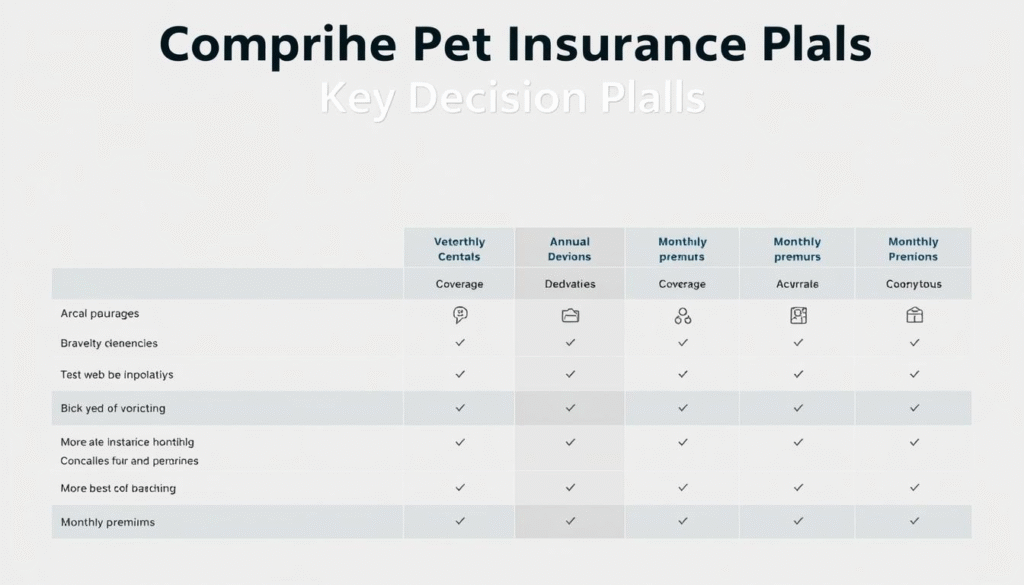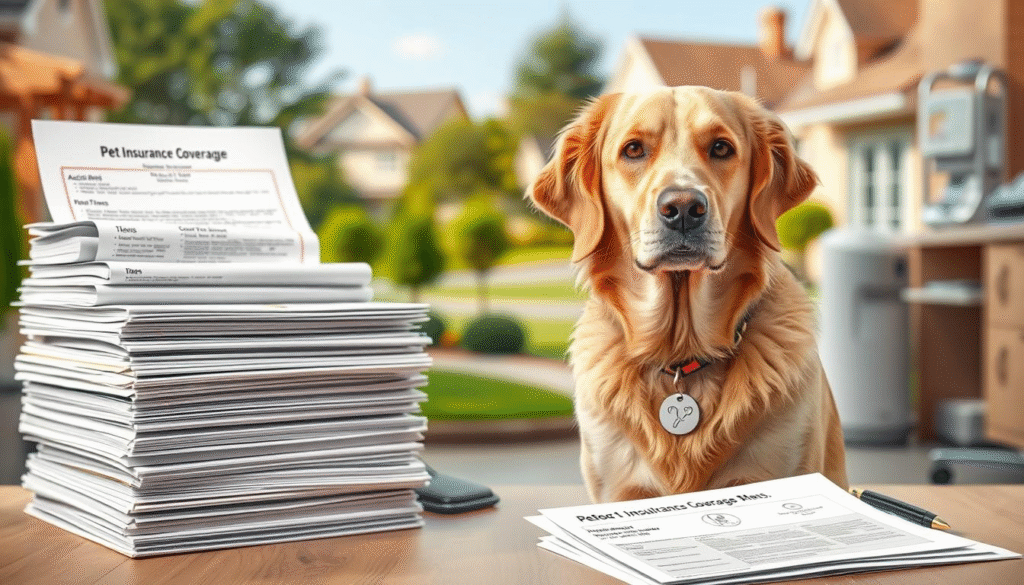Veterinary bills for pets can be unexpectedly high, with some procedures costing thousands of dollars. This financial strain can be overwhelming for many pet owners. Fortunately, there’s a solution: comprehensive coverage can provide financial protection against such unexpected expenses.

Fetch Pet Insurance offers a range of benefits, including coverage for accidents, illnesses, and wellness care for dogs and cats. By investing in this coverage, you can ensure your pets receive the care they need without breaking the bank.
Key Takeaways
- Comprehensive coverage protects against high veterinary bills.
- Fetch offers coverage for accidents, illnesses, and wellness care.
- Financial protection allows pet owners to provide necessary care.
- Comprehensive coverage is a valuable investment for pet owners.
- It helps ensure pets receive the care they need.
Why Your Pets Need Health Protection
Protecting your pets’ health is vital, given the rise in veterinary costs. As a responsible pet owner, grasping the financial impact of quality care is essential.
Rising Veterinary Costs in the United States
Veterinary care expenses have seen a steady climb. In 2021, routine care for a dog averaged $225, while a cat’s routine care was $160. More serious treatments, like cancer care, can exceed $6,000.
| Pet Type | Average Routine Care Cost (2021) | Potential Complex Treatment Cost |
| Dogs | $225 | Up to $6,000 (e.g., cancer treatment) |
| Cats | $160 | Up to $6,000 (e.g., cancer treatment) |
Financial Protection for Unexpected Pet Health Issues
Pet insurance offers financial protection against unforeseen veterinary expenses. By investing in pet insurance, you can ensure your pets receive the care they need without financial strain. This is critical for pets with chronic conditions or those who experience accidents.
For instance, if your pet is diagnosed with a serious illness, pet insurance can help cover treatment costs. This allows you to focus on your pet’s recovery without financial worry.
What is Pet Insurance and How Does It Work
With veterinary costs on the rise, pet insurance is becoming a critical tool for managing pet health expenses. It’s designed to help cover the costs of veterinary care for pets. This financial protection is against unexpected accidents or illnesses.
Basic Principles of Pet Insurance Policies
Pet insurance policies operate on several basic principles. Pet owners pay a monthly or annual premium to maintain coverage. In return, the insurance provider agrees to reimburse for certain veterinary expenses, subject to policy terms and conditions. Most policies have a deductible, the amount owners must pay before insurance kicks in.
Fetch Pet Insurance, for example, reimburses up to 90% of covered vet bills after the deductible is met. It’s vital for pet owners to understand the scope of coverage. This includes what is covered and what is not. Policies often exclude pre-existing conditions, and some may have specific exclusions for certain breeds or conditions.
Reimbursement Models and Claim Processes
Pet insurance companies have different reimbursement models. Some policies reimburse a percentage of the vet bill, while others offer a fixed benefit schedule. The claim process involves submitting a claim form, the veterinary bill, and any additional required documentation. The insurance company then reviews the claim and reimburses the owner according to the policy’s terms.
As one expert notes, “Pet insurance can be a lifesaver for pet owners who are faced with unexpected veterinary bills.” By understanding how pet insurance works, pet owners can make informed decisions about their pet’s health care.
Types of Pet Insurance Coverage Available
It’s essential to grasp the various pet insurance options to make a well-informed choice. Policies differ in their coverage, ranging from accident-only to all-encompassing plans that include wellness and preventive care.
Accident-Only Coverage
Accident-only insurance is a basic form that covers vet bills from sudden accidents. This could be a car hit or eating something toxic. It’s more budget-friendly but doesn’t cover illnesses or routine care.
Accident and Illness Coverage
Accident and illness insurance offers more, covering both accidents and a variety of illnesses. This includes infections, allergies, and chronic conditions. It’s a more protective option but comes with a higher cost.
Comprehensive Coverage
Comprehensive insurance goes beyond accident and illness, adding wellness and preventive care, or even alternative therapies. It’s the most protective for pets but also the priciest.
Wellness and Preventive Care Add-ons
Wellness and preventive care add-ons are optional. They can be added to basic policies for routine care like vaccinations, dental care, and check-ups. These extras help keep your pet healthy and prevent serious problems.
| Type of Coverage | Description | Typical Cost |
| Accident-Only | Covers veterinary costs from accidents | Lower |
| Accident and Illness | Covers accidents and a range of illnesses | Moderate |
| Comprehensive | Includes accident, illness, and additional benefits | Higher |
| Wellness and Preventive Care Add-ons | Covers routine care and preventive measures | Varies |
Healthy Paws Pet Insurance Review
Healthy Paws Pet Insurance is known for its extensive health coverage for dogs and cats. It offers a variety of plans tailored to different pet owners’ needs. This makes it a top choice among pet insurance providers.
Company Overview and Plan Options
Healthy Paws is celebrated for its all-encompassing coverage. This includes accidents, illnesses, and even wellness care. They provide unlimited annual and lifetime benefits. This is a major plus for pet owners with pets needing continuous care.
Coverage Details
The coverage spans diagnostic tests, surgeries, and medications. Healthy Paws also covers alternative therapies like acupuncture and chiropractic care. This broad range of coverage is a significant benefit for pet owners.
Pricing Structure
Pricing is determined by the pet’s age, breed, and location. While specific costs vary, Healthy Paws is often competitive with other major providers. This makes it a viable option for many pet owners.
Pros and Cons Analysis
A major plus of Healthy Paws is its flexible coverage options and excellent customer service. Some might find the pricing a bit higher than others. There are also waiting periods for certain conditions.
Best Suited For
Healthy Paws is perfect for pet owners looking for extensive coverage with flexible plans. It’s ideal for those with pets that have ongoing health issues or need regular vet visits.

Nationwide Pet Insurance Review
Nationwide Pet Insurance has long been a leader in the pet insurance field. It offers a variety of plans to meet different pet needs. This review aims to provide an in-depth look at the company, its plans, coverage, pricing, pros, and cons. This will help you determine if Nationwide is the best fit for your pet.
Company Overview and Plan Options
Nationwide Pet Insurance provides a range of plans for dogs and cats. These include major medical, whole pet, and wellness plans. Their coverage is designed to be all-encompassing, addressing accidents, illnesses, and preventive care.
Coverage Details
The specifics of coverage vary by plan. Yet, Nationwide is renowned for its broad coverage of chronic, hereditary conditions, and alternative therapies.
Pricing Structure
Nationwide’s pricing is influenced by your pet’s age, breed, and location. They offer flexible deductibles and reimbursement levels. This allows you to tailor your plan to fit your budget.
Pros and Cons Analysis
Pros:
- Comprehensive coverage options
- Customizable plans
- Excellent customer service
Cons:
- Premiums can be higher than some competitors
- Some plans have limitations on certain conditions
Best Suited For
Nationwide Pet Insurance is ideal for pet owners seeking extensive coverage. It’s perfect for those willing to invest in premium coverage. It’s also suitable for pets with chronic or hereditary conditions.
Embrace Pet Insurance Review
Embrace Pet Insurance has become a major force in the pet insurance industry, providing extensive coverage for dogs and cats. As veterinary care costs rise, pet owners are looking for dependable insurance to safeguard their pets’ health.
Company Overview and Plan Options
Embrace Pet Insurance offers a variety of plans tailored to different needs. Their policies are adaptable, enabling pet owners to select coverage that aligns with their budget and their pet’s requirements.
Coverage Details
Embrace’s coverage spans accidents, illnesses, and wellness care. They reimburse for vet visits, surgeries, and even alternative treatments like acupuncture.
Pricing Structure
Embrace’s pricing is influenced by the pet’s age, breed, and location. Generally, their premiums are competitive with other leading pet insurance providers.
Pros and Cons Analysis
Embrace’s standout feature is its all-encompassing coverage and adaptable deductible options. Yet, some pet owners find the premiums, often higher for older pets, to be steep.
Pros:
- Comprehensive coverage options
- Flexible deductible choices
- Coverage for alternative therapies
Cons:
- Premiums can be higher for older pets
- Some claims may be denied due to pre-existing conditions
Best Suited For
Embrace Pet Insurance is ideal for pet owners seeking thorough coverage and are prepared to invest in it. It’s most beneficial for owners of pets with ongoing health issues or those who prefer alternative treatments.
| Plan Features | Description |
| Accident Coverage | Covers unexpected accidents and injuries |
| Illness Coverage | Includes coverage for various illnesses and conditions |
| Wellness Care | Optional coverage for routine care and check-ups |
ASPCA Pet Health Insurance Review
The ASPCA Pet Health Insurance offers a variety of plans for dog and cat owners in the United States. It focuses on providing extensive coverage to help manage pet health care costs. This is essential for pet owners to ensure their pets receive the best care without financial burden.
Company Overview and Plan Options
ASPCA Pet Health Insurance has plans for different needs. These plans cover accidents, illnesses, and wellness care for dogs and cats. They are designed to meet the unique requirements of each pet.
Coverage Details
The coverage includes diagnostic tests, treatments, and medications for various conditions. It also offers optional wellness coverage for routine care. This ensures pets receive the necessary care for their health.
Pricing Structure
The pricing is based on the pet’s age, breed, and location. Pet owners can customize deductibles and coverage limits. This flexibility allows them to tailor their plans according to their needs and budget.
Pros and Cons Analysis
Pros: The insurance offers extensive coverage options, flexible plans, and a simple claim process. Cons: It does not cover pre-existing conditions, and premiums can change based on the pet’s age and health.
Best Suited For
ASPCA Pet Health Insurance is ideal for pet owners seeking thorough coverage with adaptable plan options. It’s perfect for those who want to ensure their pets receive necessary medical care without financial strain.
Comparing Pet Insurance Plans: Key Decision Factors
Pet owners need to carefully compare pet insurance plans. These plans differ in coverage, cost, and specific conditions. It’s essential to understand these differences to choose the best plan for your pet.
Coverage Limits and Deductibles
Coverage limits and deductibles are key aspects of pet insurance. Coverage limits are the maximum amounts insurance providers pay for claims. Deductibles are the out-of-pocket costs before insurance coverage starts. Plans with higher limits and lower deductibles are more appealing but often cost more.
Waiting Periods and Pre-existing Conditions
Waiting periods are the time before coverage starts. Knowing these periods is vital to avoid coverage gaps. Also, pre-existing conditions are health issues present before policy purchase. Most plans exclude these conditions, so enrolling pets early is critical.
Age Restrictions and Breed-Specific Considerations
Some plans have age restrictions, not covering pets that are too old or young. Certain breeds may face specific considerations or exclusions due to health issues. Pet owners should consider these factors when choosing a plan.
| Plan Feature | Description | Importance |
| Coverage Limits | Maximum amount paid per claim | High |
| Deductibles | Amount paid out-of-pocket before insurance | High |
| Waiting Periods | Time before coverage becomes effective | Medium |
| Pre-existing Conditions | Health issues existing before policy purchase | High |

Cost Factors in Pet Insurance Premiums
The cost of insuring your pet is influenced by several elements. Pet insurance premiums are shaped by various factors. It’s vital for pet owners to grasp what drives these costs.
Pet Age and Breed Influence on Pricing
The age and breed of your pet significantly affect insurance premiums. Older pets are typically pricier due to a higher risk of age-related health issues. Certain breeds are more likely to suffer from specific health problems, raising premiums. For example, large breed dogs often face joint issues, while some cat breeds are prone to genetic disorders.
Location-Based Price Variations
Your location also impacts pet insurance premiums. Veterinary costs vary widely across the United States. Urban areas usually have higher vet costs than rural ones, leading to higher insurance premiums. Areas with a high cost of living also see increased premiums to account for higher vet care costs.
Customizing Coverage to Control Costs
Pet owners can tailor their insurance to manage costs. By selecting the right deductible, coverage limits, and add-ons, owners can align their policy with their budget. For instance, choosing a higher deductible can lower premiums but means paying more out-of-pocket for claims. Understanding these options helps pet owners make informed decisions about their insurance.
Specialized Pet Insurance for Dogs and Cats
Dogs and cats have unique insurance needs. Specialized pet insurance plans cater to these specific requirements. Providers offer various coverage options tailored for each pet’s needs.
Dog-Specific Coverage Options
Insurance for dogs often includes protection against breed-specific health issues. For example, larger breeds like Great Danes are more prone to hip dysplasia. Smaller breeds, such as Chihuahuas, may face dental problems. Some plans also cover training and behavioral issues. This is because a well-behaved dog is less likely to get into accidents or cause damage.

Cat-Specific Coverage Options
Cats benefit from specialized insurance, too. This is vital for conditions like chronic kidney disease or hyperthyroidism, common in older cats. Some plans also cover dental care and injuries from cat fights. Plus, certain insurers offer coverage for genetic conditions specific to certain breeds.
It’s essential for pet owners to compare different insurance plans and their coverage options. By choosing a plan that fits their dog or cat’s specific needs, pet owners can ensure their pets receive the best care.
How to File and Maximize Pet Insurance Claims
Understanding the process of filing pet insurance claims is key to maximizing benefits. Pet owners who grasp the documentation and submission steps can ensure claims are handled efficiently. This knowledge is vital for a smooth experience.
Documentation Requirements
To successfully file a pet insurance claim, having the right documents is essential. These include the veterinary bill, a detailed treatment description, and sometimes the pet’s medical history. Ensure all documents are legible and complete to avoid claim processing delays.
Fetch Pet Insurance, for instance, offers a simple claim submission process. Reimbursement is usually quick, within a few days. Understanding your insurance provider’s specific needs can greatly simplify the process.
Claim Submission Process
The claim submission process differs among pet insurance providers. Most offer online portals or mobile apps for claim submission. It’s vital to follow your insurer’s specific guidelines for correct claim processing.
Experts agree that the ease of claim submission is a key factor in choosing a pet insurance provider. Knowing the submission process can reduce stress and make the experience more manageable.
Tips for Faster Reimbursements
To speed up reimbursement, submit claims promptly and include all necessary documentation. Double-check your claim for completeness before submission to avoid delays.
Keeping open communication with your insurance provider and following up on claim status can also ensure a smooth reimbursement process.
Conclusion: Choosing the Right Pet Insurance for Your Companions
Pet insurance is a vital part of being a responsible pet owner. Choosing the right plan requires careful consideration. Several factors are important, such as coverage limits, deductibles, waiting periods, and pre-existing conditions.
When choosing pet insurance, it’s key to consider what coverage your pet needs. This could range from accident-only to more extensive coverage including wellness and preventive care.
| Provider | Coverage Limit | Deductible |
| Healthy Paws | Unlimited | $100-$500 |
| Nationwide | $5,000 – $10,000 | $100-$500 |
| Embrace | Up to $30,000 | $100-$500 |
In conclusion, pet insurance for companions is more than just financial protection. It’s about ensuring your pets get the care they deserve. By carefully evaluating your options and considering your pet’s specific needs, you can make an informed decision.
Sources
For further information on pet insurance, the following sources were consulted:
- Fetch Pet Insurance
- Union Power Insurance Brokers – Fetch Pet Insurance Partnership
- PetInsurance.com
- ASPCA Pet Health Insurance
These pet insurance sources offer valuable insights into the various types of coverage available. They help pet owners make informed decisions about their pets’ health protection.
References to these sources throughout this article aim to provide a complete understanding of pet insurance options. This ensures that pet owners can choose the best plans for their beloved companions.
FAQ
What is pet insurance, and how does it work?
Pet insurance is designed to help cover the costs of veterinary care for pets. It reimburses owners for expenses related to accidents, illnesses, or health issues. The specifics depend on the policy.
What are the different types of pet insurance coverage available?
There are several types of pet insurance coverage. Accident-only plans cover emergencies, while accident and illness plans offer broader protection. Then, there are the more extensive, all-inclusive plans. Wellness add-ons cover routine care and preventive measures.
How do I choose the best pet insurance for my pet?
Choosing the right pet insurance involves several factors. Consider coverage limits, deductibles, waiting periods, and pre-existing conditions. Also, think about your pet’s age and breed. Comparing different providers and plans will help you find the best fit.
What factors influence the cost of pet insurance premiums?
Pet insurance premiums are influenced by several factors. These include the pet’s age, breed, health conditions, and location. Adjusting deductibles or coverage limits can also affect your premium costs.
How do I file a pet insurance claim?
To file a claim, you’ll need to submit a claim form and relevant documentation. This includes veterinary records and invoices. The exact process may vary by insurance provider.
Can I get pet insurance for my older pet?
Yes, many providers offer coverage for older pets. The availability and terms can vary. Some insurers may have age restrictions or specific coverage limitations for older pets.
Are pre-existing conditions covered by pet insurance?
Generally, pet insurance does not cover pre-existing conditions. Yet, some insurers may offer coverage for certain conditions after a waiting period or under specific circumstances.
How can I maximize my pet insurance claims?
To maximize your claims, understand your policy’s coverage and exclusions. Keep detailed veterinary records and submit claims promptly. Following the insurer’s guidelines can also help.
Is pet insurance worth the cost?
Pet insurance can be worth the cost if it provides financial protection against unexpected vet bills. It allows you to provide necessary care without financial strain.
Can I compare pet insurance plans online?
Yes, comparing pet insurance plans online is convenient. It allows you to review different providers, coverage options, and pricing. This helps you find the best fit for your pet’s needs.
